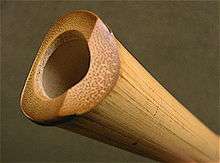Hotchiku

Hotchiku (Jp: k. 法竹 h. ほっちく, "bamboo of [the] dharma"; lit. "dharma bamboo"), sometimes romanized as hocchiku or hochiku, is a Japanese end-blown flute (a fue), crafted from root sections of bamboo. After cleaning and sanding, the heavy root end of the bamboo stalk reveals many small circular knots where the roots formerly joined the stalk. The same part of the bamboo plant is also used to produce the shakuhachi but, unlike the shakuhachi, the hotchiku's inside (bore) and outside surfaces are left unlacquered and its mouthpiece is not inlaid. The membranes at the nodes inside a hotchiku bore are generally left more intact than those of a shakuhachi. Together, these characteristics make for a visibly and audibly raw and organic instrument. Hotchiku are sometimes referred to as jinashi nobekan, meaning "without ji (a paste made of clay and lacquer, used to smooth the bore on shakuhachi), one-piece" (hotchiku are not cut in two pieces for crafting or storage, unlike shakuhachi).

Hotchiku have four holes down the front for fingers and one hole on the back for the thumb of the upper hand. The instrument is capable of a range of at least two octaves, and more if well crafted and in the hands of an experienced player; they can be fashioned to any length, suitable bamboo permitting, with longer instruments having their frequency range shifted proportionally lower. Hotchiku are typically, though not always, longer than shakuhachi, and almost always thicker and heavier.

The techniques for playing hotchiku are similar to shakuhachi techniques, although the sound resulting from hotchiku is more fragile and possibly less well tuned to musical scales than the refined shakuhachi. The angle of the utaguchi (歌口, lit. "singing mouth"), or blowing edge, of a hotchiku is closer to perpendicular to the bore axis than that of a shakuhachi but this is mostly a choice of the maker depending upon the size of the bamboo. This property, along with the unlacquered bore, results in a rough and breathy timbre. Because of its extremely natural construction, the hotchiku is commonly used for Suizen (blowing Zen meditation). Playing traditional honkyoku would only be attempted by highly technically skilled shakuhachi musicians since the blowing and fingering techniques required for honkyoku have to be altered considerably. Since hotchiku are not generally tuned to a standard musical scale, they do not commonly accompany other instruments.
Famous hotchiku players
External links
- Close up of Hotchiku, by Kinya Sogawa
- Article detailing differences between hotchiku and shakuhachi, by Tom Deaver
- One of several messages in a thread on shakumail, describing the history of the term and concept of hotchiku, contrasted with shakuhachi